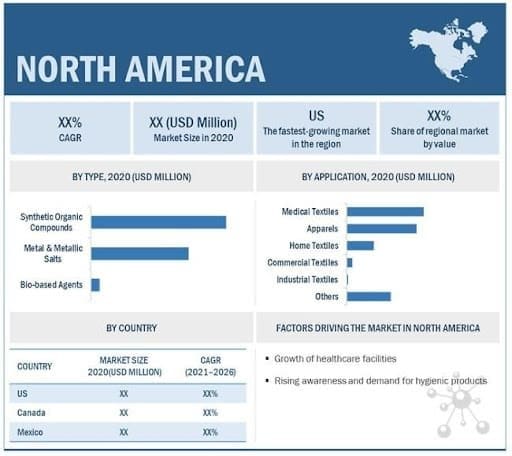The report “Global Antimicrobial Textile Market by Active Agents (Synthetic Organic Compounds, Metal & Metallic Salts, Bio-based), Application (Medical Textiles, Apparels, Home Textiles), Fabric (Cotton, Polyester, and Polyamide), and Region – Global Forecast to 2026″, size is projected to grow from USD 10.7 billion in 2021 to USD 14.7 billion by 2026, at a CAGR of 6.5% from 2021 to 2026. Growth of the market is primarily triggered by the need for hygiene products to combat the increasing number of infections due to microorganisms in various applications such as sportswear, protective wear, curtains & drapes, carpets, surgical supplies & wipes, bedding, intimates, and footwear.

In terms of value & volume, the synthetic organic compounds segment is estimated to lead the antimicrobial textiles market in 2020.
The synthetic organic compounds segment accounted for the largest market share in the antimicrobial textiles market. Synthetic organic active agents are compounds more stable due to the presence of carbon atoms in their molecular structure. Synthetic organic compounds treated textiles are projected to dominate the market as a result of its different modes of antimicrobial actions against a variety of microorganisms and easy availability of these agents.
Cotton antimicrobial textiles is widely used.
Based on fibers, the cotton segment is projected to be the largest segment in the antimicrobial textiles market. Cotton is the most commonly used fabric around the world after polyester. Textiles made out of cotton are used for applications including clothing, bath towels, bedsheets, and other industrial applications. It is also most vulnerable to microbial attack as it is a naturally occurring fiber. Cotton can be given antimicrobial properties by applying metal or non-metallic salts such as silver, copper, or chitosan.
In terms of value & volume, medical textiles is estimated to be the fastest-growing segment in the antimicrobial textiles market.
Medical textiles are projected to witness the highest growth in the antimicrobial textiles market. The rising number of infectious disease through HAIs and cross-infection highlight the need for antimicrobial textiles. Moreover, the rising demand for disposable medical textiles and growing awareness toward hygienic products increases the demand for antimicrobial textiles in the medical industry.
The APAC region is projected to be the fastest-growing region in the antimicrobial textiles market during the forecast period.
The APAC region is projected to be the fastest-growing region in the antimicrobial textiles market in terms of both value and volume from 2021 to 2026. This region is witnessing the highest growth rate due to the rapid economic expansion. According to the IMF, China and India are among the fastest-growing economies globally. India is expected to overtake China with the highest growth rate, thus driving the global economy. The rising disposable income of people, shifting of manufacturing facilities from developed regions, such as North America and Europe, and rapidly growing industrial sectors are expected to drive the market in APAC. North America accounted for the largest market share of about 33.0%, in terms of value in 2020. The growth of the market in this region is attributed to the flourishing medical textile industry, presence of large customer base and leading companies in the region, which in turn, has increased the consumption of antimicrobial textiles. With the increased consumer awareness regarding health and hygiene and the growing demand for high-quality textile products has resulted in a rise in demand for antimicrobial textiles.
Milliken & Company (US), PurThread Technologies (US), Trevira GmbH (Germany), Thai Acrylic Fiber Co. Ltd. (Thailand) and Vestagen Protective Technologies, Inc. (US), amongst others, are the key players operating in the antimicrobial textiles market.
